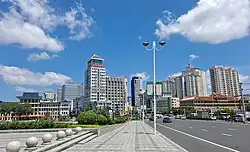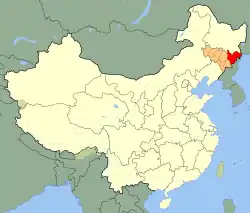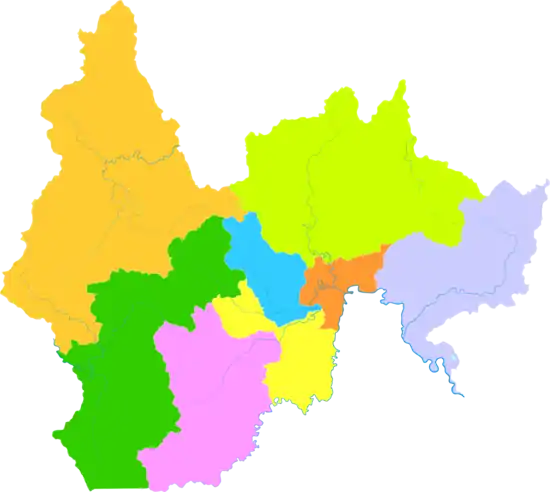Yanbian Korean Autonomous Prefecture
The Yanbian Korean Autonomous Prefecture[lower-alpha 1] is an autonomous prefecture in the east of Jilin Province, China. Yanbian is bordered to the north by Heilongjiang Province, on the west by Jilin's Baishan City and Jilin City, on the south by North Korea's North Hamgyong Province and on the east by Primorsky Krai in Russia. Yanbian is designated as a Korean autonomous prefecture due to the large number of Chaoxianzu (part of ethnic Koreans in China) living in the region. The prefectural capital is Yanji and the total area is 42,700 square kilometres (16,500 sq mi).
Yanbian Korean Autonomous Prefecture | |
|---|---|
| Chinese transcription(s) | |
| • Simplified Chinese | 延边朝鲜族自治州 |
| • Hanyu Pinyin | Yánbiān Cháoxiǎnzú Zìzhìzhōu |
| Korean transcription(s) | |
| • Chosŏn'gŭl | 연변조선족자치주 |
| • McCune–Reischauer | Yŏnbyŏn Chosŏnjok Chach'iju |
| • Revised Romanization | Yeonbyeon Joseonjok Jachiju |
 Yanji, the prefectural seat of Yanbian | |
 Location of Yanbian Prefecture (red) in Jilin Province (orange) and Mainland China (yellow) | |
| Coordinates: 43°08′N 129°11′E | |
| Country | China |
| Province | Jilin |
| County-level divisions | 6 county-level cities 2 counties |
| Prefectural seat | Yanji |
| Government | |
| • Party Secretary | Jiang Zhiying |
| • Governor | Hong Qing |
| Area | |
| • Total | 43,509 km2 (16,799 sq mi) |
| Population (2010) | |
| • Total | 2,271,600 |
| • Density | 52/km2 (140/sq mi) |
| • Ethnic composition | |
| Time zone | UTC+8 (China Standard) |
| Area code | +86 433 |
| ISO 3166 code | CN-JL-24 |
| Licence plate prefixes | 吉H |
| Website | www |
| Yanbian Korean Autonomous Prefecture | |||||||||||
|---|---|---|---|---|---|---|---|---|---|---|---|
 "Yanbian" written in Simplified Chinese and Chosŏn'gŭl | |||||||||||
| Simplified Chinese | 延边朝鲜族自治州 | ||||||||||
| Traditional Chinese | 延邊朝鮮族自治州 | ||||||||||
| |||||||||||
| Chinese Korean name | |||||||||||
| Chosŏn'gŭl | 연변조선족자치주 | ||||||||||
| |||||||||||
The prefecture has an important Balhae archaeological site: the Ancient Tombs at Longtou Mountain, which includes the Mausoleum of Princess Jeonghyo.
History
In the Ming dynasty, Yanbian was governed by the Jianzhou Guard (建州衛) and in the late Qing dynasty the area was divided into the Yanji (延吉廳) and Hunchun (琿春廳) subprefectures. From 1644 to the 1800s the Manchurian administrators of the Qing state attempted to separate Northeast China, politically and ethnographically, into a "Manchuria" to which they could retreat in case an ethnically Han Chinese dynasty regained control over China. However, this effort failed because of the trading and agricultural opportunities available to Han Chinese migrants in the northeast region which made it profitable to evade the rules, as well as later Qing relaxation of the same rules (Chuang Guandong) to discourage Russian encroachment.[1][2]
In the late 19th century, Korean immigrants migrated en masse from the Korean Peninsula to China. After the foundation of the Republic of China, a second wave arrived. Of the 2 million ethnic Koreans in Manchuria at the time of the communist takeover, 1.2 million remained in the region after the end of World War II. Many participated in the Chinese Civil War, most on the side of the Chinese communists. When the civil war was over, the new Chinese government gave these Koreans their own autonomous region (区) in 1952. Yanbian was upgraded to an ethnic autonomous prefecture in 1955. During the Cultural Revolution, violent clashes and killings occured in Yanbian.[3]
Korean (Joseon) migration into Northeast China began in significant numbers in the last quarter of the 19th century and was mainly motivated by economic hardship on the Korean side of the border. After the Japanese annexed Korea in 1910, a small but significant number of migrants also came to Manchuria for political reasons.[4]
In 1952, the Korean migrants comprised some 60% of the local population, but by 2000 that was down to 32%. The Chinese authorities subsidize Korean language schools and publications, but also take measures to prevent an emergence of Korean irredentism in the area. From the late 1990s, the Chaoxianzu have assimilated into mainstream Chinese culture with increasing speed, often switching to daily use of Chinese and choosing to attend Chinese-language schools.[5]
Geography
- Geographic coordinates: 41° 59' 47" – 44° 30' 42" N, 127° 27' 43" – 131° 18' 33" E
- Total border length: 755.2 kilometres (469.3 mi)
- With North Korea: 522.5 kilometres (324.7 mi)
- With Russia: 232.7 kilometres (144.6 mi)
Mountains that are in the prefecture are:
- Changbai Mountains (central range)
- Zhangguangcai Range
- Harba Peak (哈尔巴岭)
- Peony Peak (牡丹领)
- Old Master Peak (老爷岭)
- Nangang Mountain Range (南岗山脉)
There have been over 40 types of minerals and 50 kinds of metals – including gold, lead, zinc, copper, silver, manganese and mercury – discovered near or in the mountains.
The average land height is 500 metres above sea level.
Main rivers include:
- Songhua River
- Mudan River (Peony River)
- Tumen River
- Gaya River (branch of the Tumen)
- Hunchun River
The rivers sustain 28 running water processing facilities. They created basins, which are suitable for agricultural uses, like rice paddies and bean farms.
Administration
The prefecture is subdivided into eight county-level divisions: six county-level cities and two counties:
| Map | ||||||||||||
|---|---|---|---|---|---|---|---|---|---|---|---|---|
| Name | Chinese (S) | Hanyu Pinyin | Chinese Korean transliteration | Population (2003 est.) | Area (km2) | Density (/km2) | ||||||
| Joseongeul | Revised | McCune | ||||||||||
| Yanji City | 延吉市 | Yánjí Shì | 연길시 | Yeongil-si | Yŏngil-si | 410,000 | 1,332 | 308 | ||||
| Tumen City | 图们市 | Túmén Shì | 도문시 | Domun-si | Tomun-si | 130,000 | 1,142 | 114 | ||||
| Dunhua City | 敦化市 | Dūnhuà Shì | 돈화시 | Donhwa-si | Tonhwa-si | 480,000 | 11,963 | 40 | ||||
| Hunchun City | 珲春市 | Húnchūn Shì | 혼춘시 | Hunchun-si | Hunch’un-si | 220,000 | 4,938 | 45 | ||||
| Longjing City | 龙井市 | Lóngjǐng Shì | 룡정시 | Ryongjeong-si | Ryongjŏng-si | 250,000 | 2,592 | 96 | ||||
| Helong City | 和龙市 | Hélóng Shì | 화룡시 | Hwaryong-si | Hwaryong-si | 210,000 | 5,069 | 41 | ||||
| Wangqing County | 汪清县 | Wāngqīng Xiàn | 왕청현 | Wangcheong-hyeon | Wangch’ŏng-hyŏn | 250,000 | 8,994 | 28 | ||||
| Antu County | 安图县 | Āntú Xiàn | 안도현 | Ando-hyeon | Ando-hyŏn | 210,000 | 7,444 | 28 | ||||
The above counties and cities are divided into 642 villages (边境村).
Transportation
Railways include:
- Chang-Tu Line (长图线)
- Mu-Tu Line (牡图线)
- Chao-Kai Line (朝开线)
- Yangchuan-Shantun Line (阳川山屯线)
- Jilin–Hunchun intercity railway (吉珲客运专线)
There are 1,480 km (920 mi) of public roads altogether. There are four airports.
Demographics
Ethnic composition:
- 2,271,600 (2010)
- 64.55% Han Chinese
- 32.45% Korean
- 2.52% Manchu
- 0.28% Hui
- 0.13% Mongols
- Growth rate 0.4%.
Population density: 51 inhabitants per square kilometer (130 inhabitants per square mile).
As on the Korean peninsula, the most common surname among Yanbian Koreans is Kim (Jin [金] in Chinese). Many emigrated from Korea during the 19th century and again during the Japanese occupation.
Between 1952 and 2002, the Yanbian Korean Autonomous Prefecture had among the highest rates of urbanization (城市化率) at 55.6%, 20 percentage points greater than the provincial average (31.3%) and 25 more than the national average (26.5%).[6]
Education
Colleges and universities:
- Yanbian University, which uses both Chinese and Korean as instruction mediums.[7]
- Yanbian University of Science and Technology[8]
International schools:
Culture
Both Mandarin Chinese and Chaoxianzu style Korean are used as official languages in Yanbian.
The Museum of Yanbian Korean Autonomous Prefecture was planned in 1960, and constructed in 1982. It contains over 10,000 exhibits, including 11 first-level artifacts. The exhibits' labels and explanations are bilingual in Korean and Chinese and tour guides are also available in both languages.
Tourism

There are seven public parks in Yanbian's green space (18% of whole prefecture), including:
- Yanji People's Park (延吉人民公园)
- Youth Lake Park (青年湖公园)
Also popular among locals during holidays and festivities.
Nature and environment
Over 70% are originally forest in the prefecture, so there is a rich diversity of life.
Sports

Yanbian Korean Autonomous Prefecture is an important region for Chinese football. Over 50 years, more than 40 footballers have been selected by the China national team.
The first professional football team in this prefecture is Jilin Three Stars Football Club. From 1994 to 2000, this club had played each year in the top Chinese football league. In 2000, they were relegated from the top league. Because of poor economic conditions the club was sold to Lucheng Group in Zhejiang Province.
Yanbian Longding plays in the 30,000-seater Yanji Stadium in China League One, the second tier of the Chinese football league system.
In 2016, Yanbian Football Club was sponsored by Shenzhen Funde Group (Chinese: 富德集团) when they got the permission of Chinese Super League, since they acquired the 1st place in the Chinese Second League in 2015.
See also
Notes
References
Citations
- Lee, Robert H. G. (1970). The Manchurian frontier in Chʼing history. Internet Archive. Cambridge, Harvard University Press. p. 103. ISBN 978-0-674-54775-9.
- Matsuzato, Kimitaka (2016-12-07). Russia and Its Northeast Asian Neighbors: China, Japan, and Korea, 1858–1945. Rowman & Littlefield. pp. 27–28. ISBN 978-1-4985-3705-6. Archived from the original on 2 October 2022. Retrieved 8 August 2022.
- Lovell, Julia (2019-09-03). Maoism: A Global History. Knopf Doubleday Publishing Group. pp. 114–115. ISBN 978-0-525-65605-0.
Events took a horrific turn in the frontier town of Yanbian, where freight trains trundled from China into the DPRK, draped with the corpses of Koreans killed in the pitched battles of the Cultural Revolution, and daubed with threatening graffiti: 'This will be your fate also, you tiny revisionists!'
- Min, Pyong Gap (1992). "A Comparison of the Korean Minorities in China and Japan". International Migration Review. 26 (1): 4–21. doi:10.2307/2546934. JSTOR 2546934. PMID 12285045.
- Lankov, Andrei (2007-08-16). "The Gentle Decline of the 'Third Korea'". Asia Times Online. Archived from the original on 2007-08-27. Retrieved 2007-08-17.
{{cite web}}: CS1 maint: unfit URL (link) - Li, Yabiao 李亚彪; Wang, Jinghe 王景和 (2002-09-02). "Jílín Yánbiān Cháoxiǎnzú Zìzhìzhōu chéngshìhuà shuǐpíng zǒuzài quánguó qiánliè" 吉林延边朝鲜族自治州城市化水平走在全国前列. Xinhua (in Simplified Chinese). Archived from the original on October 1, 2002. Retrieved 2007-07-15.
- "Yanbian University". Study in China : China University Admission. Retrieved 2023-05-19.
- "YUST | YUST PUST Foundation". www.yustpust.org. Retrieved 2023-05-19.
Sources
- 延边朝鲜族自治州概编写组编写 (June 2009). 延边朝鲜族自治州概况 [Overview of Yanbian Korean Autonomous Prefecture] (in Chinese). Beijing: Publishing House of Minority Nationalities. ISBN 978-7-105-08642-9.
Further reading
- Cathcart, Adam (2010). "Nationalism and Ethnic Identity in the Sino-Korean Border Region of Yanbian, 1945–1950" (PDF). Korean Studies. 34: 25–53. doi:10.1353/ks.2010.a413032. JSTOR 23720146. S2CID 161128900.
External links
- Official government website (in Chinese)
- Official government Tourism website
- Yanbian Office in Korea (in Korean)
- Yanbian Korean Autonomous Prefecture Archived 2011-09-03 at the Wayback Machine: by the Information Office of Jilin Provincial Government
- A map labeled in Chinese written in the list in the "Administration" section Archived 2009-09-26 at the Wayback Machine
